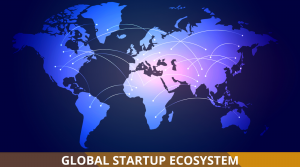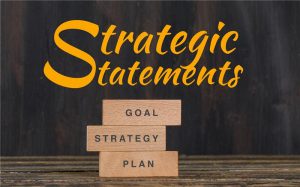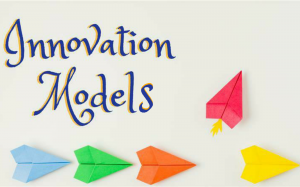Ever wonder how your business will make money? Generating income by selling your products is the basic idea that comes to our mind. While this certainly is one of the types of business models. There are more than 50 different business models.
The blog discusses 18 examples of business models widely used by some top startups giving you an idea about which one and when to opt for.
Most profitable startups never invented new business models. They prefer to borrow it from other organizations & yes it works.
The Razor and Blades model have been highly profitable for Adobe document readers and Verizon’s cell phone business. The cheap-chic business model works for IKEA in the home furnishing business & Trader Joe’s in the grocery business.
Today, the type of business model depends on the usage of technology and innovation. Sometimes, one little twist in a present business model can deliver strong results in a new industry.
So, why do people choose Facebook? It is simply because they can chat and connect with other people around the world (operating model) and do not even charge for it (revenue model).
In this blog, starting with a short description of what exactly is a business model, I will discuss 18 Business Model Examples opted by startups and established firms. I will help you analyze which one works for you.
What is a Business Model?
A business model is a logical structure that supports the feasibility of the business. Designing a business model requires deep thought and analysis.
A business model provides a reason for the customer to choose the offering provided by your company over others. Business models focus on core strategy, customer interface, value network, and resources.
“All it really meant was how you planned to make money” — Michael Lewis
How do you write a business model?
Business Models are created with the help of a business model canvas. In more simple terms, every business model has three parts –
- designing and manufacturing the product
- From finding the right customers to selling and distributing the product
- how the customer will pay and how the company will generate income
As you can see, a successful business model just needs to collect more money from customers than it costs to make the product. You can lower costs during design and manufacturing, finding more effective methods of marketing and sales & figuring out an easy way for customers to pay.
You don’t have to come up with a new business model, you could take an existing business model and offer it to different customers. For example, restaurants mostly work on a standard business model and focus their strategy by targeting different kinds of customers.
Business Model Example
Many people associate business models with lengthy documents but business models do not need to be a long document. A concise, visual document is required to distill the key elements of your strategy and ensure everyone understands the high-level approach. So let’s discuss the various business models with their examples.
1. Subscription Business Model
In the subscription business model, customers pay a fixed amount of money on fixed time intervals to get access to the product or service provided by the company. The major problem is user conversion; how to convert the users into paid users.
When & Why you should opt for the Subscription Business Model.
The subscription model is used because of its pricing structure, in which a business will charge customers a recurring fee to access their product or service.
This model should be used by those companies in which the revenue strategy depends on a customer paying multiple (recurring) and subscription based payments for prolonged access to a good or service.
So let’s see how this model works for Netflix. Netflix is a subscription service providing online streaming videos that work on a membership-based model. The clients pay every month for access to TV shows, documentaries, motion pictures, and other media content in various qualities.

2. Freemium Business Model
“Freemium” means “Free” and “Premium” service. It offers two types of services to the customers, ‘free service’ and ‘paid service’. The free service users have limited access to the basic features whereas the premium services are unlocked when the person buys the paid service.
When & Why you should opt for the Freemium Business Model.
The Freemium model should be adopted by companies when they are looking to grow their business and brand quickly. This model is preferred because everybody likes free stuff, and nobody wants to pay money for something they’re not sure will work for them.
So, the freemium model addresses that by providing such an enticing offer: giving users the ability to experience a new product without any risk.
For instance, MailChimp is an email marketing platform that began as a paid service and later added a freemium option in 2009. MailChimp allows the users to collect email list subscribers, create autoresponder series, send regular email updates, and automate their marketing.
Its free plan allows the users to have 2,000 subscribers and 12,000 emails per month, whereas the priced plans give more advanced features. The regular user mostly turns into a paid user as it would be hectic to change the platform once you have 2,000 listed subscribers.

3. Open Source Business Model
Open source business model provides service/product offered for free, and a business/enterprise version which is paid. In the freemium and business model, the free product is built, developed, and maintained by the company centrally.
In the open-source model, the free product is built, developed, and in part, maintained by an open community of developers. Those developers are a part of an independent community.
When & Why you should opt for the Open Source Business Model.
Open source business models should be used by a company when they have an aim to create a superior product, which immediately has a competitive advantage, and which generates multiple scalable revenue streams.
The open-source business model relies on shifting the commercial value away from the actual products and generating revenue through ancillary services like systems integration, support, tutorials, and documentation.
Let’s discuss the open-source business model of Fastly.Inc which is an American cloud computing services provider. Fastly leverages an active community of developers and a good chunk of revenue is spent on sales and marketing processes. For a monthly fee, customers get access to the platform & account management with enhanced customer support.

4. Consulting Business Model
Unlike traditional businesses that have a clearly defined product or tool to sell, a consulting or agency business model provides a specific set of services for a fee. While this business model can be applied to almost any industry, the main drawback of consulting business models is that you should have expertise and authority around your brand.
When & Why you should opt for the Consulting Business Model.
Companies adopt consulting business models as they don’t have either the time or expertise to do specific tasks. This business model should be followed by those companies whose unique value proposition is based on the knowledge and expertise of its people.
For example, Alcor Fund which is a global private equity fund that acts as an advisory with a strong knowledge of the investment market. It offers fund and asset management, merger and acquisition, private equity, and corporate finance.
It operates through its investment bank & its consulting wing under ALCOR Advisors that advise the clients to take their companies on a rapid growth path through a focused strategy.
Neil Patel. Neil Patel Digital is the SEO and digital marketing agency that allows Neil Patel to monetize its traffic by offering free basic content marketing tools while charging for the premium.
The idea was simply that you generate enough qualified leads, set up a team to manage those projects, and grow the agency based on on-coming projects.

5. Distributor Business Model
A distribution-based business model focuses on a company’s ability to have one or a few key distribution channels to connect to its final user or customer.
When & Why you should opt for the Distributor Business Model.
This model should be adopted when the survival of a company depends on its ability to have one or a few key distribution channels to connect to its final user or customer. In a distribution model, you don’t need to manufacture products of your own, you can comfortably engage in the distribution of the products of a company or several companies at the same time.
Unilever spends its major part of revenue in maintaining a proper distribution. The company is providing a proper distribution network to its brands by working with thousands of retailers and wholesaler suppliers across the world, with a massive supply chain.
Big companies like Unilever having a large turnover, focus on their distribution strategy. They spent most of their resources to tap into channels that can prove to be successful to scale up their business.

6. Aggregator Business Model
An aggregator business model involves an aggregator that might act as a middleman. In an aggregator model, it’s the aggregator that keeps interacting with the two or more parties involved.
When & Why you should opt for the Aggregator Business Model.
Aggregator business model should be followed by a company in which it is not just a mediator but a firm with a brand for providing the goods/services from smaller providers. This model allows a company to connect with different goods/service providers and sell its goods/services under its brand.
For instance, Google shows users a search result page, and the same Google handles the ad inventors. Hence users and advertisers don’t interact with each other to set the price. Google as a search engine is more of an aggregator, where the company centrally enriches its index and builds up its rankings.

7. Conceptual Business Model
A conceptual business model is a diagram that demonstrates to us how an industry or business functions. It shows an essential element in the business and tells how those elements relate to each other.
When & Why you should opt for the Conceptual Business Model.
Businesses should adopt a conceptual business model if their business often requires concepts and ideas to create innovative products. This model defines project scope, establishes entities with concepts, and provides a high level of understanding in different product development cycles.
For example, Maruti Suzuki a car company might create a conceptual model of a new car to be introduced in the market. This model is based on several or a single concept in design.
Conceptual models often require research to generate ideas into more specific concepts. Companies should perform consumer research to get an idea for what appeals most to consumers.

8. Razor and Blade Business Model
In the razor and blade model, the basic product (hook) is offered cheaply or free while the complementary product or refill (bait) is sold expensively. We cannot use the basic product without a corresponding product. It is easy to attract customers with the “bait” product because it seems to them like they are getting a bargain. This model is one of the Small business strategy examples.
When & Why you should opt for the Razor and Blade Business Model.
Razor & Blade models are applied by companies when they have a complementary product that encourages repeat purchases. This business model allows the companies to sell their initial product for little to no profit & relying instead on the initial sale to cover their customer acquisition costs.
Companies like Apple use an inverse razor and blade, business model. Apple has created platforms like the iTunes and App Store, which sell songs, apps, movies, or web series at an appropriate price. Apple also charges premium prices on its devices like the iPhone, iPad, and Mac.

9. SaaS Business Model
SaaS or Software as a Service business model is a centrally-hosted software that is hosted on a cloud infrastructure. Customers pay a subscription fee to utilize the software.
Zendesk is a customer service ticketing system famous for its usability by small, medium, and even large businesses. It provides a better customer service experience.
XERO is a huge SaaS model and a popular choice of many accountants to manage their clients. Auditox Accountancy uses around 5 different accountancy SaaS programmes but Xero is the one that they say most people feel comfortable with. This is a classic example of something used on mass markets with a high margin of return.

10. Direct Sales Business Model
When it comes to the small business model, the direct sales business model involves selling a product directly to the targeted customer. chubbies adopted a direct sales model.

11. Advertising Business Model
The advertising model works by providing a free product or service that people want to consume. Later, it displays ads to those readers or viewers. Youtube is following the ad-based business model.

12. Affiliate Marketing Business Model
An affiliate business model allows a firm to sell the products of other companies on their website. Like this company named Khojdeal is selling bluestone products with the help of discount coupons or the famous Amazon Affiliate Program follows the affiliate marketing business model.

13. Peer to Peer Business Model
A P2P business is a platform between consumers and individual service providers. It provides revenue by taking a percentage of all sales made through their platform.
Airbnb follows a peer to peer business model by charging guests a service fee between 5% and 15% of the reservation, while the commission from hosts is generally 3%.

14. Franchise Business Model
A franchise exists when a parent corporation creates a unique product, a strong brand, and a replicable business model. Later, it sells it to others to own and operate independently. Starbucks is a retail company that sells coffee-related beverages.

15. Amazon Business Model
The Amazon model includes online stores (which account for 52% of Amazon revenues), as well as physical store locations. It also includes AWS services like site hosting, subscription services, third-party sellers, and advertising revenue.
Jeff Bezos famously said “Your margin is my opportunity”

16. Ecommerce Business Model
The eCommerce model focuses on selling products by creating a web-store on the internet (online shop). Amazon, Alibaba, ebay, olx, and Walmart are some of the big companies that have adopted an e-commerce business model.

17. On-Demand Business Model
The on-demand business model is based on “Access is better than ownership rule”. The products & services are easily accessible to the customer in less time. On-demand laundry & dry cleaning service of uber is evolving & has radically mixed well.

18. Uber Business Model
Uber runs according to a ‘two-sided’ marketplace business model. The company acts as the middleman or broker between the drivers and those who need a ride. The company earns profits from each transaction, taking a percentage from gross booking.

Conclusion
Before we conclude, I would like to share an important factor to keep in mind that the most successful business models are dynamic and repeatedly evolving. Brands operate with more than one business model. The business model examples can help entrepreneurs find the formula to build a successful company.
Business models are helpful for analysis to understand how businesses work. Though they have found customers, the model fails because of lack of resources. According to Bill Gross, the founder of Idealab, “timing is the most important factor”.
The success of a business model depends on the timing, context, and market conditions. Successful and profitable business models generally have substantial brand equity with a strong distribution network.
We at Alcor help founders build their idea from scratch to the growth stage. Explore your fundraising options with us on Venture capital, private equity, debt funding and more.








